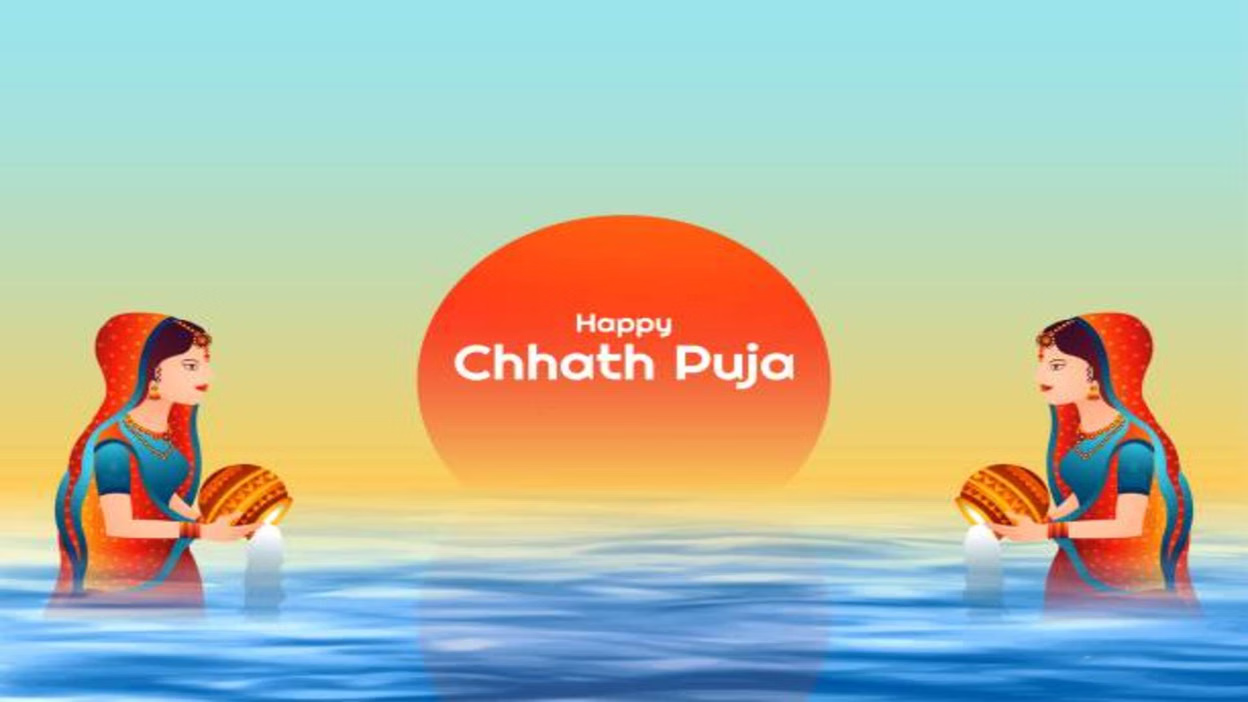Chhath Puja is one of the most revered Hindu festivals, primarily observed in Bihar, Jharkhand, eastern Uttar Pradesh, and parts of Nepal. Dedicated to Lord Surya (the Sun God) and Chhathi Maiya, the festival signifies gratitude, purity, and devotion. Celebrated over four days, it is marked by rigorous fasting, holy bathing, and offering arghya (oblations) to the Sun at sunrise and sunset. Each day of Chhath Puja holds deep spiritual significance, but the third day—Sandhya Arghya— is the most celebrated phase of the entire observance.
The four days of Chhath Puja are known as Nahay Khay, Kharna, Sandhya Arghya, and Usha Arghya. The first day, Nahay Khay, begins the spiritual cleansing process; Kharna marks the fasting period; Sandhya Arghya involves offering prayers to the setting Sun; and Usha Arghya concludes the rituals with offerings to the rising Sun. The third day of Chhath Puja, known as Sandhya Arghya, reflects the worshippers’ gratitude to Lord Surya and Chhathi Maiya for sustaining life on earth through light and energy.
During Sandhya Arghya, devotees gather along riverbanks or ponds to perform divine rituals as the Sun begins to set, symbolizing the cycle of life, humility, and continuity of faith.
Significance of Sandhya Arghya (Evening Offering)
The term Sandhya Arghya translates to “evening offering.” This sacred ritual involves offering water and other items to the setting Sun. The act of offering arghya is not merely a symbolic gesture—it signifies surrender, thankfulness, and harmony with nature. The setting Sun represents balance, forgiveness, and completion. By bowing before the descending rays, devotees express gratitude for another day of life, prosperity, and health.
The evening arghya is particularly significant in the Hindu tradition because it acknowledges the dual nature of creation—light and darkness, life and rest, beginnings and endings. Offering prayers at dusk symbolizes acceptance of life’s transitions while reaffirming the continuous faith in divine order.
Spiritually, pouring water at dusk during Sandhya Arghya reflects the merging of the individual soul (atma) with universal consciousness (paramatma). The ritual unites families, neighborhoods, and entire communities, emphasizing the cultural unity that defines this festival across regions.
Date and Muhurat of Sandhya Arghya 2025
In 2025, Chhath Puja will be observed from Monday, October 27 to Thursday, October 30. The Sandhya Arghya ritual will take place on Wednesday, October 29, 2025. Devotees will offer the evening prayers as the Sun sets.
Sandhya Arghya Muhurat (2025):
- Date: October 29, 2025 (Wednesday)
- Sunset Time: 5:17 PM (approx., varies by location)
- Auspicious Duration: 4:50 PM to 5:30 PM
Following the exact muhurat for offering arghya is considered highly auspicious, as it aligns prayer with natural celestial energy. The calm of sunset is believed to enhance spiritual vibrations, making this time ideal for devotion and meditation.
Preparations Before Sandhya Arghya
Preparation for the Sandhya Arghya begins early in the day. Devotees strictly observe fasting, maintaining bodily and spiritual purity. The fast is rigorous—many devotees abstain from both food and water till the offering is made.
Ritual preparations also include the cleaning and decorating of the ghat, symbolizing purity and devotion. The riverbank or pond is adorned with colorful rangoli, flowers, and earthen lamps (diyas). Families bring bamboo baskets known as soop, filled with offerings like fruits, sugarcane, rice laddoos, and thekua, a traditional sweet made from wheat flour and jaggery.
Items used in Sandhya Arghya include:
- Thekua (sacred sweet offering)
- Fruits like bananas, coconuts, and lemons
- Sugarcane stalks
- Diya (earthen lamp)
- Flowers and incense sticks
- Milk and holy water
The purity of offerings reflects the sincerity of faith and the reverence devotees hold for Chhathi Maiya and Surya Dev.
Step-by-Step Sandhya Arghya Vidhi
Step 1 – Procession to the Ghat
As evening approaches, families gather and walk towards the ghat while chanting traditional Chhathi Maiya ke geet. The air vibrates with devotional songs, drum beats, and joyful community participation. This collective procession strengthens family bonds and spreads divine positivity.
Step 2 – Setting Up for Worship
Upon reaching the ghat, devotees organize their offerings neatly beside the water. A small altar is arranged with the soop, diya, flowers, and fruits. As the Sun begins to dip below the horizon, devotees step into the water with humility and folded hands, preparing for the sacred offering.
Step 3 – Offering Arghya to the Setting Sun
The core ritual of Sandhya Arghya begins as devotees offer water to the setting Sun while chanting Surya Mantras. The water, poured slowly from palms or a vessel, reflects golden rays symbolizing divine blessings. Devotees sing traditional Chhath geet and light diyas, which float serenely on the water, illuminating the dusk in gratitude and love.
Step 4 – Prayers and Aarti
The ritual concludes with aarti dedicated to both Lord Surya and Chhathi Maiya. Devotees pray for family well-being, prosperity, and strength to lead a wholesome life. Families often exchange blessings before returning home, carrying the sanctity of the divine evening within their hearts.
Cultural and Regional Traditions
Chhath Puja varies slightly across regions, reflecting India’s diverse cultural fabric. In Bihar, the festival is marked by folk songs and large communal gatherings on riverbanks. In Jharkhand, rural families focus on simplicity and purity, emphasizing traditional prasad offerings. In Uttar Pradesh, decorative lamps and community arrangements make Sandhya Arghya visually majestic.
Women, especially mothers and daughters, play a central role in maintaining and performing rituals. The transmission of songs, customs, and rituals from one generation to another preserves cultural continuity and identity.
During Sandhya Arghya, folk songs and traditional dances become part of the devotion, glorifying Chhathi Maiya and celebrating life’s endurance and fertility.
Significance of Water and Sun in Sandhya Arghya
Both water and the Sun hold vital spiritual symbolism in Sandhya Arghya. Water represents purity, nourishment, and the cyclical essence of life, while the Sun embodies energy, hope, and renewal. Offering arghya to the setting Sun embodies the harmony between nature and human existence.
The philosophy behind worshipping the setting Sun lies in acknowledging the day’s completeness and expressing gratitude for what has been received. It teaches detachment from material desires and recognition of life’s impermanent yet beautiful nature. This balance of humility and gratitude cultivates emotional clarity and spiritual growth.
The practice also highlights environmental respect—worship near natural water bodies encourages cleanliness and awareness of ecological balance.
Devotional Foods and Prasad Items
Food prepared during Chhath Puja reflects purity and devotion. Thekua, a sweet made of wheat flour, ghee, and jaggery, is the central prasad for Sandhya Arghya. Other offerings include kheer-puri, fresh fruits, coconuts, sugarcane, and seasonal produce. Each item is prepared without salt or onion-garlic, maintaining ritual purity.
These prasads represent simplicity and the idea that divinity resides in pure, honest offerings. After worship, the prasad is distributed among family members, neighbors, and guests, spreading love and blessings.
Conclusion
Sandhya Arghya, the third day of Chhath Puja, symbolizes one of the most spiritually charged moments of the festival. It represents unwavering faith, purity of body and soul, and deep gratitude toward natural elements. The evening offering unites families and communities in thanksgiving and reinforces moral values—discipline, purity, and humility.
Through the serene reflection of the setting Sun, devotees connect with the cyclical balance of life and nature. Chhath Puja’s message of harmony, faith, and sustainability continues to strengthen social and cultural unity, reminding everyone that gratitude is the truest form of devotion.
FAQs
Q1. What is Sandhya Arghya in Chhath Puja?
Sandhya Arghya is the evening ritual of offering water and prayers to the setting Sun during the third day of Chhath Puja.
Q2. Why is the setting Sun worshipped in Chhath Puja?
The setting Sun symbolizes forgiveness, fulfillment, and the eternal rhythm of life. Worshipping it expresses gratitude and balance.
Q3. What are the key items required for Sandhya Arghya?
The main items include thekua, fruits, coconut, sugarcane, diya, flowers, and holy water.
Q4. What is the difference between Sandhya Arghya and Usha Arghya?
Sandhya Arghya is offered to the setting Sun in the evening, while Usha Arghya is offered to the rising Sun on the concluding day.
Q5. How do devotees prepare for the third day of Chhath Puja?
They observe a fast, clean and decorate the ghat, prepare offerings, and perform the ritual at sunset following traditional customs.
Krishna Mishra writes for Insights of Hinduism, where he shares heartfelt thoughts on festivals, traditions, and the timeless wisdom of Sanatan Dharma. His aim is to keep the essence of Hindu culture alive in a way that feels simple, authentic, and relatable to everyone.


